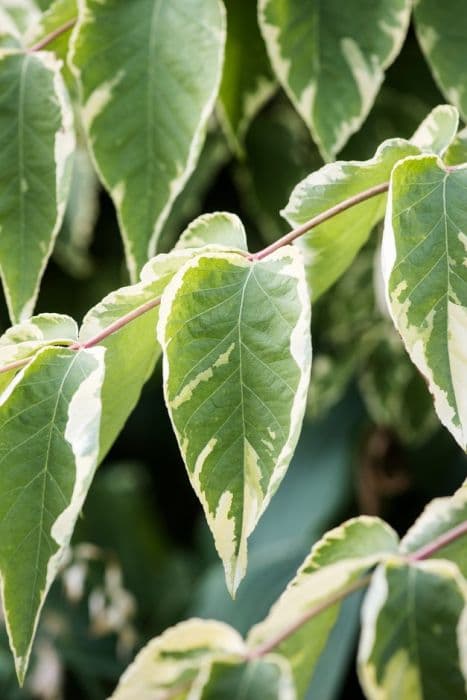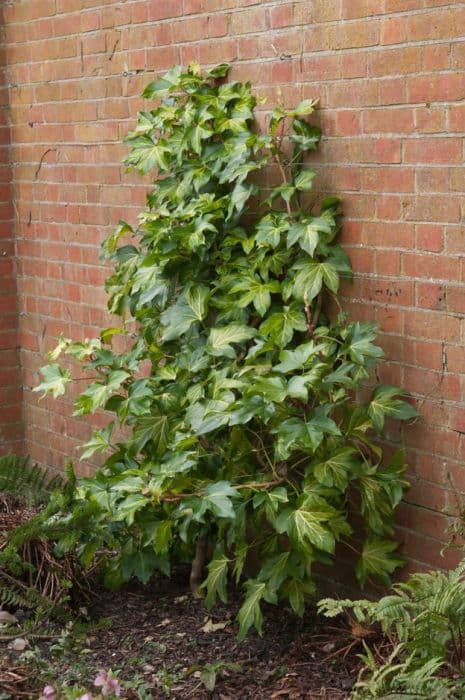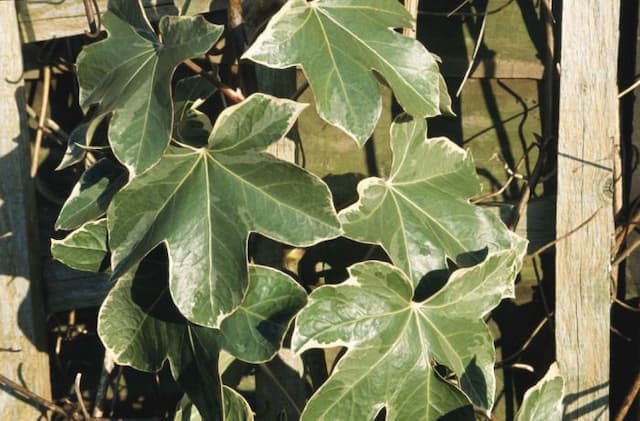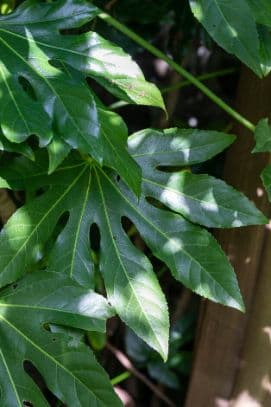English Ivy Hedera helix 'Duckfoot'

ABOUT
Hedera helix 'Duckfoot', commonly known as the English ivy 'Duckfoot', is a distinctive variety of the classic English ivy. This plant is well-regarded for its unique foliage. The 'Duckfoot' name derives from the shape of its leaves, which resemble a duck's foot. The leaves are typically smaller than those of the standard English ivy and exhibit a broad shape with a more pronounced look—three to five lobes spread out in a manner that suggests the webbed foot of a duck. English ivy 'Duckfoot' has a rich green color that remains vibrant throughout the year. The leaves have a glossy texture, which adds to their visual appeal and allows them to catch the light, giving the plant a lively presence. The leaves grow closely together, creating a dense and lush mat of foliage which can be quite striking in appearance. The stems of this ivy are slender and flexible, enabling the plant to climb surfaces or spread across the ground. Despite not discussing the specifics of the plant's size, it should be noted that English ivy 'Duckfoot' can adapt itself well to different growing conditions, whether it is placed in a container for indoor decoration or used outdoors where it blends seamlessly with other plants in a garden. Overall, the charming appearance of English ivy 'Duckfoot', with its green, glossy, and uniquely shaped leaves, make it a popular choice for gardeners and plant enthusiasts who want to add texture and character to their plant collections.
About this plant
 Names
NamesFamily
Araliaceae.
Synonyms
English Ivy, Common Ivy, European Ivy, Ivy.
Common names
Hedera helix 'Duckfoot'.
 Toxicity
ToxicityTo humans
English ivy, including the 'Duckfoot' variety, is considered toxic if ingested. It contains compounds such as saponins, which can cause a variety of symptoms. These may include stomach pain, vomiting, diarrhea, and excessive salivation. In severe cases, it can also lead to difficulty in breathing, fever, polydipsia (increased thirst), delirium, hallucinations, and even convulsions. Contact with the sap may cause skin irritation, redness, itching, or blisters in sensitive individuals.
To pets
For pets, English ivy is also toxic. If ingested by animals such as cats and dogs, it can cause similar symptoms as in humans. These symptoms include vomiting, abdominal pain, hypersalivation, and diarrhea. Depending on the amount ingested, more severe symptoms could occur, which might include muscle spams, convulsions, or even coma. It's important for pet owners to prevent their pets from chewing or ingesting any part of the plant to avoid these potential health issues.
 Characteristics
CharacteristicsLife cycle
Perennials
Foliage type
Evergreen
Color of leaves
Green
Height
6-8 inches (15-20 cm)
Spread
1-1.5 feet (30-45 cm)
Plant type
Climber
Hardiness zones
5-11
Native area
Europe
Benefits
 General Benefits
General Benefits- Aesthetic Appeal: The Duckfoot Ivy is known for its unique, webbed foliage which adds visual interest to gardens and indoor spaces.
- Versatility in Landscaping: It can be used as a groundcover, in hanging baskets, as a climbing vine, or simply as ornamental foliage in gardens.
- Low Maintenance: Duckfoot Ivy requires minimal care, thriving in a variety of light conditions and requiring infrequent watering once established.
- Adaptability: It is capable of adapting to various soil types and can tolerate a range of pH levels.
- Seasonal Interest: Provides year-round greenery in mild climates, contributing to winter garden landscapes when other plants may be dormant.
- Tolerance to Neglect: This plant can survive occasional neglect, making it suitable for those who may not have much time for gardening.
- Fast Growth: It grows relatively quickly, which can be desirable for covering spaces or achieving a mature look in a short amount of time.
- Durable: It’s known for being hardy and can resist different urban pollution levels, making it a good choice for city environments.
 Medical Properties
Medical Properties- Expectorant: Hedera helix, commonly known as English ivy, is used to relieve respiratory conditions by helping to loosen mucus and phlegm.
- Anti-inflammatory: It contains saponins and flavonoids that are believed to reduce inflammation.
- Antimicrobial: The plant has been suggested to possess antimicrobial properties that can help fight certain bacteria and viruses.
- Antispasmodic: Traditionally used to alleviate muscle spasms, particularly in the context of coughs and other respiratory ailments.
- Topical treatment for skin disorders: The saponins found in English ivy may help in treating certain skin conditions when applied topically.
 Air-purifying Qualities
Air-purifying QualitiesThis plant is not specifically known for air purifying qualities.
 Other Uses
Other Uses- Hedera helix 'Duckfoot' can be cultivated as a living sculpture by training its growth around wireframes to create interesting garden art.
- The plant is used in topiary gardens for its ability to be shaped into geometric forms and animal figures.
- Due to its dense growth habit, English ivy 'Duckfoot' can be used for creating privacy screens on patios or balconies.
- It can serve as natural carpeting in shaded garden areas, where grass might struggle to grow.
- English ivy 'Duckfoot' is utilized for greening up vertical spaces like walls or fences, providing a lush backdrop.
- This ivy variant is sometimes used in themed gardens, such as 'storybook' gardens, to add a sense of whimsy and enchantment.
- In model landscapes or train sets, the small leaves of 'Duckfoot' ivy can be employed to represent larger tree varieties in miniature scale.
- Creative plant enthusiasts may use small cuttings of English ivy 'Duckfoot' for crafting botanical jewelry, like living necklaces or bracelets.
- This plant can be used in fairy gardens, where its small-scale foliage complements miniature houses and accessories.
- Photographers may utilize English ivy 'Duckfoot' as a lush green prop or backdrop for portraits and macro photography.
Interesting Facts
 Feng Shui
Feng ShuiEnglish Ivy is used to promote good energy flow and improve indoor air quality. It can be placed in the family (east) or health (east-center) sectors of the home to introduce wood element, which can enhance growth and renewal.
 Zodiac Sign Compitability
Zodiac Sign CompitabilityEnglish Ivy is not used in astrology practice.
 Plant Symbolism
Plant Symbolism- Connection: English Ivy often symbolizes connection and friendship due to its ability to attach firmly to surfaces, representing strong bonds in relationships.
- Eternal Life: Because of its evergreen nature, English Ivy is frequently associated with immortality and eternal life.
- Fidelity: The tenacious grip of its vines has led to it being a symbol of faithfulness and everlasting love in marriage and friendships.
- Protection: Traditionally, English Ivy has been believed to ward off evil spirits, making it a symbol of protection and safety.
- Growth and Renewal: English Ivy's vigorous growth habits signify continual growth and renewal, encouraging progress and new beginnings.
- Survival: Its ability to thrive in challenging conditions symbolizes resilience and the ability to survive against the odds.
- Memory and Remembrance: In some cultures, English Ivy is a representation of remembrance, commonly used in memorials and to honor past relationships.
 Water
WaterEnglish Ivy 'Duckfoot' should be watered when the top inch of soil feels dry to the touch, typically every 7 to 10 days, depending on the environment it's kept in. It's best to water deeply until water runs out of the bottom of the pot, ensuring the roots are adequately moistened. Over a month, expect to water about 3-4 times, with each watering involving around half a gallon to a gallon for a standard-sized indoor pot, depending on the pot size and indoor conditions.
 Light
LightEnglish Ivy 'Duckfoot' thrives in bright, indirect light but can also adapt to medium light conditions. It should be placed near a north- or east-facing window where it can receive gentle morning light or filtered afternoon light. Direct sunlight should be avoided, as it can scorch the leaves.
 Temperature
TemperatureEnglish Ivy 'Duckfoot' prefers temperatures between 50-70 degrees Fahrenheit for optimal growth. It can tolerate a minimum temperature of around 30 degrees Fahrenheit but should not be exposed to freezing conditions. The ideal indoor environment would maintain a consistent temperature within the preferred range, avoiding sudden temperature fluctuations.
 Pruning
PruningEnglish Ivy 'Duckfoot' should be pruned to encourage bushier growth, control its size, and remove any dead or damaged leaves. The best time to prune is in the spring before new growth starts. Prune as needed throughout the year to maintain the desired shape and health of the plant, but avoid heavy pruning in the fall as the plant prepares for dormancy.
 Cleaning
CleaningAs needed
 Soil
SoilEnglish Ivy 'Duckfoot' thrives best in soil that is rich, moist, well-draining, with a pH range of 5.5 to 6.5. A good soil mix is one part peat, one part pine bark, and one part coarse sand or perlite to provide appropriate drainage and aeration.
 Repotting
RepottingEnglish Ivy 'Duckfoot' should be repotted every two to three years to refresh the soil and accommodate root growth. Choose a pot that is slightly larger than the current one to allow for growth.
 Humidity & Misting
Humidity & MistingEnglish Ivy 'Duckfoot' prefers high humidity levels, ideally around 40-50%. Maintaining higher humidity will encourage lush growth and healthy foliage.
 Suitable locations
Suitable locationsIndoor
Provide bright, indirect light and occasional pruning.
Outdoor
Plant in shaded to semi-shaded areas; protect from hot sun.
Hardiness zone
5-11 USDA
 Life cycle
Life cycleThe common name for Hedera helix 'Duckfoot' is English ivy. This plant begins its life cycle when a seed germinates in moist, fertile soil, typically in the shade. As a juvenile, the ivy exhibits lobed, duckfoot-shaped leaves and has a creeping growth habit as it establishes itself, using aerial rootlets to climb surfaces if available. Once mature and when conditions are favorable, usually after several years, the English ivy enters into the adult vegetative stage, characterized by unlobed leaves and the development of woody vines. The reproductive stage follows, where the plant produces umbrella-like inflorescences with small, inconspicuous flowers that are pollinated by insects, leading to the production of berry-like fruits. These fruits are dispersed by birds, enabling the seeds within to potentially germinate and begin a new lifecycle.
 Propogation
PropogationPropogation time
Spring-Early Summer
The English Ivy cultivar known as 'Duckfoot' is typically propagated via stem cuttings. The best time to take cuttings for propagation is late spring through early summer, when the plant is actively growing. To propagate English Ivy 'Duckfoot', snip a 4 to 6-inch piece of stem just below a leaf node—a point on the stem where leaves emerge. Remove the leaves from the lower half of the cutting to expose the nodes, as roots will develop from these points. The cut end can be dipped in rooting hormone powder to encourage faster root development before planting the stem cutting into a pot filled with a moistened mix of peat and perlite. The pot should be covered with a plastic bag to maintain humidity and placed in indirect light. Roots typically establish in a few weeks, after which the cutting can be potted in regular potting soil.









